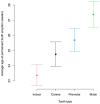Development of Yorkshire Terrier Dentition
- PMID: 37505812
- PMCID: PMC10384937
- DOI: 10.3390/vetsci10070406
Development of Yorkshire Terrier Dentition
Abstract
The development of dentition in dogs has been associated with several problems including tooth over-crowding, missing permanent dentition, and persistent deciduous teeth (PDT). Information on dentition development in different breeds is lacking. This study of 61 Yorkshire terriers aimed to determine the (i) average age at deciduous tooth exfoliation, (ii) average age at permanent tooth eruption, (iii) PDT incidence, and influencing factors such as body weight. The ages of exfoliation of deciduous teeth and eruption of permanent dentition were influenced by body weight and tooth type. These dentition changes tended to occur later in dogs ≤ 3 kg versus dogs > 5 kg. Generally, incisors were exfoliated first, followed by premolars and then canines. At a body weight of 4.5 kg, the middle of the data range, the estimated age at loss of deciduous teeth (with 95% confidence intervals) was 21.9 (21.1, 22.9) weeks for incisors, 26.1 (24.9, 27.4) weeks for canines, and 23.9 (22.9, 24.9) weeks for premolar. The estimated age at eruption of permanent dentition was 22.3 (21.6, 23.0) weeks for incisors, 23.8 (23.0, 24.6) weeks for canines, 24.7 (24.0, 25.5) weeks for premolars, and 26.4 (25.5, 27.3) for molar teeth. However, this sequence was disrupted in dogs ≤ 3 kg. Yorkshire terriers had a high incidence of PDT. At a body weight of 4.5 kg, the estimated proportion of PDT was: incisors 0.86% (0.32, 2.31), canines 15.62% (7.62, 29.37) and premolars 3.57% (1.62, 7.66). Canines constituted the most frequently retained tooth type, with 89.1% retained in dogs ≤ 3 kg compared to 12.0% in dogs > 5 kg. This information will enable veterinarians to provide personalised advice regarding the oral care requirements for Yorkshire terriers and highlights the need to regularly monitor this breed between the ages of two and seven months, during the active phases of tooth development.
Keywords: Yorkshire terrier; body weight; dentition development; dog; persistent deciduous teeth.
Conflict of interest statement
C.W., I.P., L.J.H. and N.D. are employees in company Mars Petcare, a provider of oral care products and veterinary services for dogs. F.S. has no conflict of interest to declare.
Figures







Similar articles
-
Time and sequence of the replacement of the deciduous by the permanent dentition in dogs and its applicability for age estimation.Anat Histol Embryol. 2023 May;52(3):460-489. doi: 10.1111/ahe.12904. Epub 2023 Jan 24. Anat Histol Embryol. 2023. PMID: 36692220
-
Time and sequence of emergence of the deciduous dentition in dogs and its applicability for age estimation.Anat Histol Embryol. 2022 Sep;51(5):640-657. doi: 10.1111/ahe.12838. Epub 2022 Jul 24. Anat Histol Embryol. 2022. PMID: 35872597
-
Molar distalization with pendulum appliances in the mixed dentition: effects on the position of unerupted canines and premolars.Am J Orthod Dentofacial Orthop. 2006 Mar;129(3):407-17. doi: 10.1016/j.ajodo.2005.12.004. Am J Orthod Dentofacial Orthop. 2006. PMID: 16527638
-
[Orthodontics in general practice 4. Impaction of maxillary front teeth].Ned Tijdschr Tandheelkd. 2008 May;115(5):252-8. Ned Tijdschr Tandheelkd. 2008. PMID: 18543692 Review. Dutch.
-
Clinical management of fusion in primary mandibular incisors: a systematic literature review.Acta Odontol Scand. 2020 Aug;78(6):417-424. doi: 10.1080/00016357.2020.1734233. Epub 2020 Mar 3. Acta Odontol Scand. 2020. PMID: 32125202
References
-
- Wiggs R., Lobprise H. Veterinary Dentistry, Principles and Practice. Raven-Lippincott; Philadelphia, PA, USA: 1997. Pedodontics; pp. 167–185.
-
- Harvey C., Emily P. Small Animal Dentistry. Mosby-Year Book; St. Louis, MO, USA: 1993. Function, formation, and anatomy of oral structures in carnivores.
Grants and funding
LinkOut - more resources
Full Text Sources

